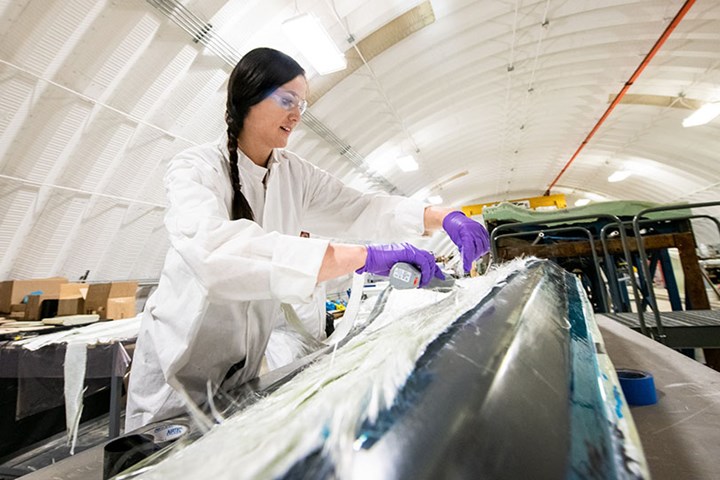NREL, Arkema research recyclable, thermoplastic composite wind turbine blades
The National Renewable Energy Laboratory and partners aim to develop more sustainable, longer-lasting turbine blades that are less expensive to manufacture.

With a goal toward recyclable wind turbine blades, researchers at the U.S. Department of Energy’s National Renewable Energy Laboratory (NREL, Golden, Colo., U.S.), in partnership with Arkema Inc. (King of Prussia, Pa., U.S.), recently demonstrated the feasibility of a thermoplastic resin, and have validated its structural integrity on a thermoplastic composite blade manufactured at NREL.
NREL has also announced the development of a technoeconomic model to explore the cost benefits of using a thermoplastic resin in blades. According to NREL, manufacturing wind turbine blades with thermoplastic resins, as opposed to conventional thermoset resins such as epoxy, would make turbine blades more recyclable and also enable longer, lighter-weight and lower-cost blades — the lower costs coming from the ability to cure NREL’s thermoplastic resin at room temperature, removing associated process and labor costs. The new process, the researchers determined, could make blades about 5% less expensive to make.
NREL is home to the Composites Manufacturing Education and Technology (CoMET) Facility at the Flatirons Campus near Boulder, Colorado. There, researchers design, manufacture and test composite turbine blades. They previously demonstrated the feasibility of the thermoplastic resin system by manufacturing a 9-meter composite wind turbine blade. They followed that demonstration by manufacturing and structurally validating a 13-meter thermoplastic composite blade compared to a near-identical thermoset blade. This work, coupled with work by Arkema and other Institute for Advanced Composites Manufacturing Innovation (IACMI, Knoxville, Tenn., U.S.) partners, demonstrated advantages to moving away from the thermoset resin system. The thermoplastic resin could also allow manufactures to build blades on site, NREL says, alleviating a problem the industry faces as it trends toward larger and longer blades.
“With thermoset resin systems, it’s almost like when you fry an egg. You can’t reverse that,” says Derek Berry, a senior engineer at NREL. “But with a thermoplastic resin system, you can make a blade out of it. You heat it to a certain temperature, and it melts back down. You can get the liquid resin back and reuse that.” Berry is co-author of a new paper titled, “Structural Comparison of a Thermoplastic Composite Wind Turbine Blade and a Thermoset Composite Wind Turbine Blade,” which appears in the journal Renewable Energy.
Related Content
-
Plant tour: Joby Aviation, Marina, Calif., U.S.
As the advanced air mobility market begins to take shape, market leader Joby Aviation works to industrialize composites manufacturing for its first-generation, composites-intensive, all-electric air taxi.
-
Carbon fiber in pressure vessels for hydrogen
The emerging H2 economy drives tank development for aircraft, ships and gas transport.
-
PEEK vs. PEKK vs. PAEK and continuous compression molding
Suppliers of thermoplastics and carbon fiber chime in regarding PEEK vs. PEKK, and now PAEK, as well as in-situ consolidation — the supply chain for thermoplastic tape composites continues to evolve.

.jpg;width=70;height=70;mode=crop)









.jpg;maxWidth=300;quality=90)

